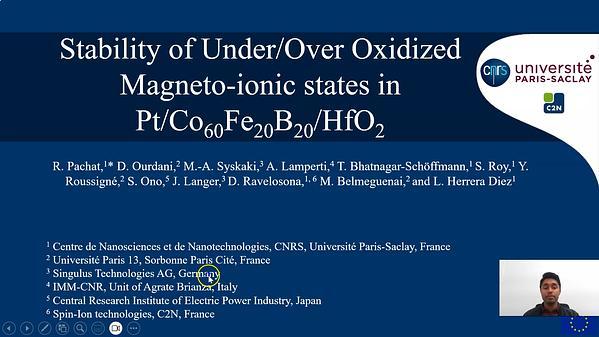Would you like to see your presentation here, made available to a global audience of researchers?
Add your own presentation or have us affordably record your next conference.
The vast multi-principal element alloy (MPEA) composition space is promising for discovery of new material phases with unique combinations of properties.1 We have explored the potential to achieve high magnetic anisotropy materials in MPEA FeCoNiMnCu thin films. Thin films of FeCoNiMnCu sputtered on thermally oxidized Si/SiO2 substrate at room temperature exhibit soft magnetic properties with a coercivity on the order of 10 Oe . After post-deposition rapid thermal annealing (RTA), the films exhibit a single face-centered cubic (FCC) phase from grazing incidence X-ray diffraction (GIXRD), as shown in Fig. 1, as well as a continuous surface morphology measured by atomic force microscopy. Magnetometry measurements reveal a coercivity of 400 Oe, a nearly 40-fold increase compared to as-grown samples. First-order reversal curve (FORC) analysis2 of the RTA sample reveals a distinct feature in the high coercivity regime of the FORC distribution, as shown in Fig. 2, indicating the presence of a single magnetic phase with much enhanced coercivity. Additionally, we have explored inclusion of Pt to facilitate uniaxial structure and enhance magnetic anisotropy. We find that RTA of the FeCoNiMnCuPt films induces ordering into an L10 intermetallic phase. A significant enhancement of coercivity to over 2 kOe after RTA has been observed, compared to 5 Oe before RTA, along with the development of an out-of-plane magnetic easy-axis, reflecting the formation of a high anisotropy L10 phase. These results demonstrate the potential in achieving high magnetic anisotropy materials using the multi-principal element approach.
This work has been supported by the NSF (ECCS-2151809).
References:
1. J.W. Yeh, S.K. Chen, S.Y. Chang et al., Adv. Eng. Mater., 6, 299-303, (2004).
2. D.A. Gilbert, J.W. Liao, K. Liu et al., APL Mater., 2, 086106, (2014).

Fig. 1. Grazing-incidence XRD for FeCoNiMnCu films (bottom) as-grown and (top) after RTA.

Fig. 2. (left ) Family of first-order reversal curves (FORC) and (right) FORC distribution of an FeCoNiMnCu film after RTA.
